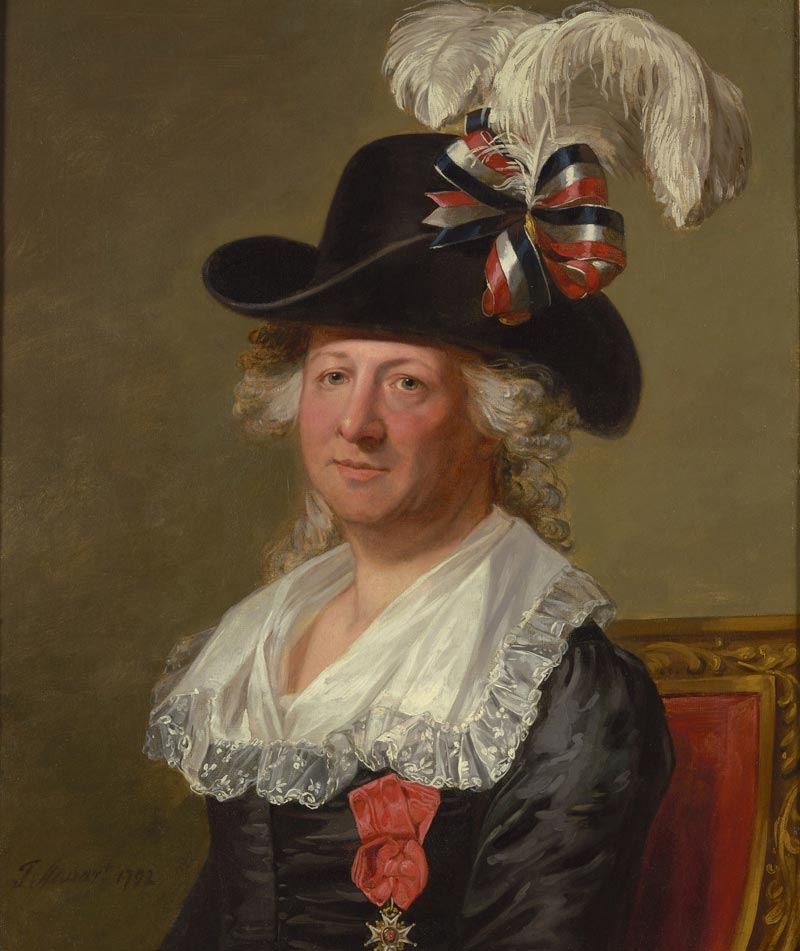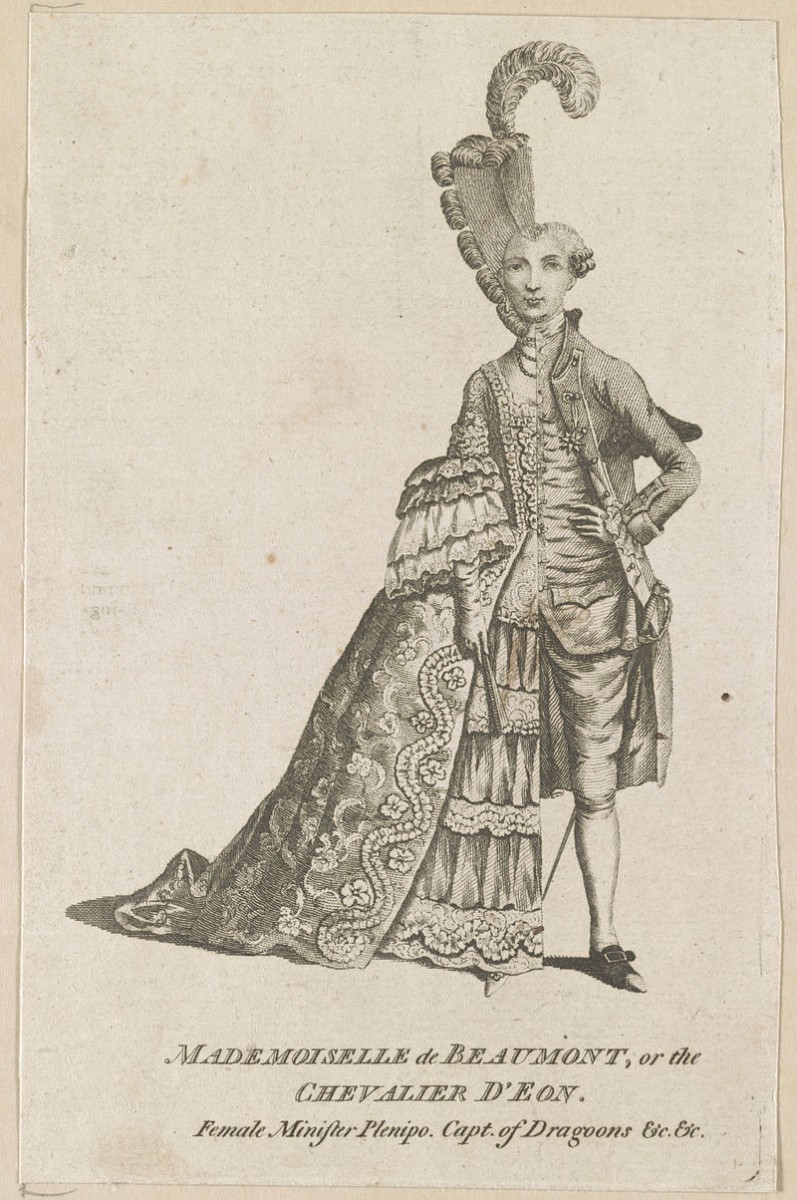Empowering Transgender Lives
Chevalier d’Eon de Beaumont
Along with being curious about our history, one of the most common questions we’re asked is:
“Why are you called the Beaumont Society – are you named after someone?”
The short answer is that we’re not named after someone per se. The Society’s name comes from the “Chevalier d’Eon de Beaumont”, a French aristocrat at the time of Louis XV who led a double life as Charles / Lia, not only in the court, but also in senior diplomatic roles in both Russia and England!
This painting of the celebrated soldier, diplomat and fencer, Chevalier d’Éon (Charles Geneviève Louis Auguste André Timothée d’ Éon de Beaumont) (1728-1810), was an important acquisition for the National Portrait Gallery as it is the earliest representation of a transgender person in the Collection.
D’Éon was respected internationally after playing a key role in peace negotiations that ended the Seven Years’ War, and later as a professional fencer, performing for George, Prince of Wales, though always fighting in women’s attire. This portrait is an unprecedented historic document of the sitter’s acceptance into British society at a time when people who wore clothing not associated with their assigned gender were viciously persecuted.
The decision to acquire the portrait was largely based on the sitter’s importance to the history of transgender people in Britain.
Chevalier d’Eon: National Portrait Gallery
The Chevalier d’Éon was as a French soldier, diplomat and spy, living both as 'Charles' and 'Charlotte.'
The Chevalier d’Éon
The Chevalier d’Éon, born Charles-Geneviève-Louis-Auguste-André-Timothée d’Éon de Beaumont on October 5, 1728, was a fascinating figure in French history. D’Éon was a diplomat, spy, and soldier who served France in various capacities during the 18th century.
D’Éon is particularly notable for living part of their life as a man and part as a woman. Initially, d’Éon presented as a man and engaged in traditionally male roles, including fighting in the Seven Years’ War and serving as a diplomat.
In 1777, d’Éon began living as a woman and was officially recognized as such by King Louis XVI. This transition was a significant and public aspect of d’Éon’s life, making them one of the most famous gender-nonconforming individuals of their time.
D’Éon passed away on May 21, 1810, in London, leaving behind a legacy that continues to intrigue historians and the public alike
The French Diplomat Who Lived as Both a Man and a Woman By: Jessica Pearce Rotondi Published: January 10, 2024
Chevalier D’eon De Beaumont – An Extraordinary Life B
At the Court of Louis XV
Charles d’Eon became famous at the court of Louis XV in the 1750’s, where a small and little-changing group of often fabulously wealthy men and women (although they did not, as we shall see, always stay that way) gathered together daily in the same glittering but mainly totally inconsequential life of the royal court. With few of life’s practical problems on their minds, boredom was very much the order of the day; only ‘the status and the enjoyment of court life’ became relevant. So, appearing in ostentatious clothing which displayed status in the most obvious way – in these particular circumstances a political expedient in itself – very quickly became the centre of their existence. Mind-blowing fashions for men and women were almost the only strong antidote to their daily ennui.
Thus, in the court of Louis XV (as it had in the time of Louis XIV), fashion was not just a personal choice but a societal force. It dictated not only the thoughts and deeds of the courtiers but also their dress. One week, a ‘Harlequin ‘ theme might dominate, following a theatrical presentation, while another might see a flurry of hats and bonnets depicting the flight of Montgolfier’s hot air balloon. Those who arrived at court out of sync with the day’s theme were not ‘seen’!
The cost of this continuous demand for exotic new clothing was staggering, even for the wealthy. Each lady’s dress or man’s flamboyant garb could cost the equivalent of a couple of thousand pounds today, and sometimes several were needed every day! A famous gold, silver, and sable suit made for the Marquis de Stainville cost ten times that – and he wore it only about five times at court before it was considered passé!
The only saving grace for the courtiers was that they were not taxed -their presence at court and the expense of maintaining their palatial houses and servants to back their position was considered duty enough! This tax exemption allowed them to spend exorbitant amounts on fashion and lifestyle, contributing to the conspicuous and extravagant waste of resources that sustained a sizeable part of the industry around Paris and Versailles. It was no wonder that so much ostentation finally fed the envy of the desperately poor and hungry beyond containment, and thus it can be said that fashion, as well as a lack of food, were at the root of the 1789 French Revolution!
Portrait de Charles d'Éon de Beaumont
In Louis XV’s court, extreme foppery was not just expected; it was a spectacle. Those who carried it to the extreme often resorted to some fantastic fashion statement to gain acceptance. Without it, the potential courtier would pass unnoticed. One such example is a young buff who was accepted as a courtier by Marie Antoinette only after he bid for notice in a scarlet coat, pink and green gilet, sky-blue satin breeches, blue and red stockings, lemon and green striped overcoat, and an enormous powdered wig.
It can easily be seen that the life of Louis XV’s courtiers had stresses of its own – as well as devouring huge sums of money, the lifestyle ate up vast amounts of time! Having retired in the wee small hours after the previous night’s revels, the lady courtier then had. Still, a few hours rest before starting the preparations for the next day’s activities, needing to be in full ball-gown-style regalia by 8 a.m. for mass! Madame de Pompadour, being even more meticulous than most, is thought to have died from the sheer exhaustion of this daily round.
In these extraordinary surroundings, where the aristocracy retained such power over the life and death of their subjects that their eccentricities went unchallenged, it is hardly surprising that transvestism played a powerful role. It seems to have been more blatant and open in high society worldwide than at any time since Nero and his decadent Roman successors. (The English Governor of New York was so egregious about his proclivities that he reviewed his troops in a ladies’ dress styled in the latest Parisian fashion for hoop and pannier skirts – reasoning afterwards that as he represented the queen, he should dress like her!)
Blackmail and a Royal Dilemma
The need to maintain two lifestyles, especially the feminine one, soon had him deeply in debt; however, d’Eon’s fortunes took another turn for the worse when Louis XV died and Louis XVI took the French throne. From his secret London hideaway, d’Eon sent messages to Paris trying to blackmail Louis XVI by threatening to disclose his spying activities.
This indeed was a royal dilemma as the new King had been making secret overtures to be on friendlier terms again with the English, as the cost of various wars was crippling the French (and other) economies. For the attempted blackmail, the Chevalier should have gone to prison, and Charles could not allow his advisors to see there was no punishment – so a unique solution was found. The Chevalier would be paid, for spying services rendered, a sum of money more than adequate to cover all his debts, and he would be allowed to return to France and live there freely – providing he did so ONLY as a woman! As such, his prison sentence was merely suspended in case he tried to revert to being Charles, and with this threat hanging over his copious wigs, he would cause the King no further trouble. This solution provided a further safeguard too, because even when ‘she’ was back in France, Charles could not risk the discovery by the English of the identity of his high level spy, or of “her” duality!



